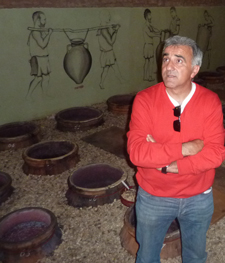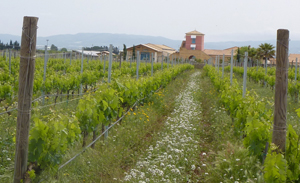COS: Not your traditional winery
© by Neil Duarte
Thirty years ago three friends from the Vittoria area of southeastern Sicily were preparing to start their university education. The friends, Giambattista "Titta" Cilia, Giusto Occhipinti and Cirino Strano, were all from wine making families. When Titta's father saw that the three had nothing to do until school started in several months, he gave them several tons of Nero d'Avola grapes and with his help, the three made 1400 bottles of very alcoholic wine. They chose the name COS for their winery name, taking the first letters of each last name. The wine was sold in Palermo and thus began the odyssey resulting today in one of the leading wineries in all of Sicily. In 1985 Cirino chose medicine over winemaking, selling his share to his sister, Pina, who stayed ten years until she left to marry the owner of Ristorante Sakaleo in nearby Scoglitti. For more details, I highly recommend you read Robert Camuto's excellent book on Sicilian wine, Palmento: A Sicilian Wine Odyssey (At Table)
 | |
| Guisto Occhipinti with the terracotta amphora. PHOTO: Terry Duarte. |
Today, COS (www.cosvittoria.it) is run by Guisto and Titta, both graduate architects. The company has expanded significantly and now produces approximately 160,000 bottles per year using biodynamic viticulture methods. The facility includes a beautiful inn, Locanda COS, on the grounds of the vineyard/winery. My wife and I stayed at the inn on our visit.
My introduction to COS came from both the aforementioned book by Robert Camuto and a bottle of COS Pithos Rosso that one of our sons had brought back from a visit to Sicily. The wine was excellent and thus during a recent trip to Sicily, we visited the winery. Our host for the tour was owner Guisto Occhipinti who proved to be a passionate and knowledgeable guide and a most hospitable host. The barrel tasting in COS's spacious new earthquake-resistant winery (remember, owners are both architects) was informative and enlightening.
COS is not your traditional winery. As Guisto explained, they have gone away from using smaller French barriques to employing terracotta amphora from Spain, and large Slovenian oak casks. The change was made to reduce the oak contact time and hence stronger oak flavor in the wine, allowing more of the true characteristics of the wine to emerge. Another interesting fact is that COS uses only the natural yeasts for fermentation of its wines.
What were the wines they offered? COS produces both white and red wines in several varieties. The first white we tasted was Rami, an IGT blend of 50 percent Inzolia and 50 percent Grecanico. This wine has a slightly fruity nose and taste plus a smooth finish. It is fermented in concrete tanks for a short period and has an alcohol content of 12 percent. The other white tasted was Pithos Biano, another IGT 12 percent alcohol wine made from 100 percent Grecanico grapes. This wine, however, is fermented in the terracotta amphora for six months and has a muted, background picture of the amphora on its label. The taste was dry and slightly fruity. I don't know much about Grecanico wines, but this was indeed a very nice wine.
 | |
| Cos winery and vineyards. PHOTO: Terry Duarte. |
Another red wine sampled was the Pithos Rosso, an IGT blend of 60 percent Nero d'Avola and 40 percent Frappato. This wine, however, is aged in the terracotta amphora which produces a different, somewhat stronger taste. Assuming Guisto is correct in his opinion that the true characteristics of the grapes are reflected in amphora fermented wines, Pithos Rosso is the real deal. I would not choose one over the other or compare the Cerasuolo to Pithos Rosso. However, if you prefer a stronger taste, I recommend the Pithos Rosso which I also rated at 92.
At an excellent and informal lunch hosted by Guisto in the dining room we tried other COS wines, including a 100 percent Frappato which was excellent. I don't remember if we also tried COS's Nero Di Lupo (literally "the black wolf"), a 100 percent Nero d'Avola that is made in a combination of terracotta amphora and concrete tanks. However, I did purchase a bottle of this and other COS wines to bring back home.
One last item is worth mentioning. We drove into Scoglitti and ate at Ristorante Sakaleo on our first night at COS. It is a pure seafood operation that may be the best such restaurant in which I have ever had the pleasure of dining. Owner Pasquale Ferrara owns a fishing boat which he uses to provide fresh seafood daily to his restaurant. From the "crudo" antipasti to the secondo (main course) of sole and giant shrimp, the food was exquisite. If you ever visit the area, do not miss a meal at Sakaleo.
July, 2011
